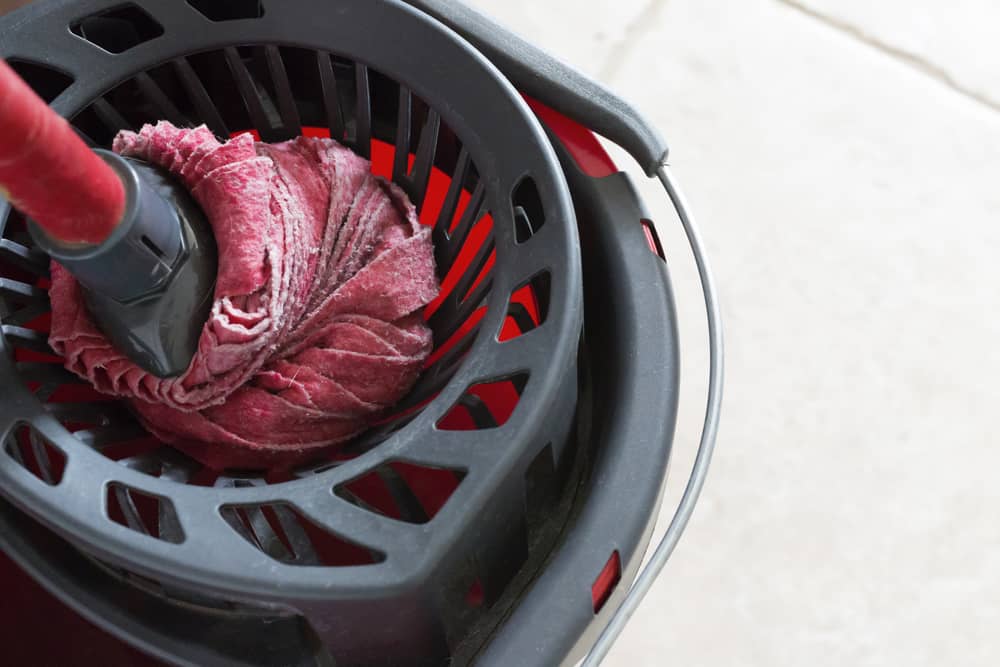Cleaning your mop isn’t exactly the most exciting thing in the world, but it’s an essential part of keeping your home clean and tidy. Not only that, but cleaning your mop regularly will help it last longer and keep it free from mould and bacteria.
Parts of a Mop
Knowing the parts of a mop and how they work together can help you take it apart and reassemble it after cleaning.
Mop Head
The mop head is typically made from cotton, microfiber, or synthetic fibres. It’s designed to pick up dirt and debris from floors.
- Cotton fibre mop heads consist of thick swaths of durable, woven cotton, which easily trap dirt and liquid.
- Microfiber mops are ideal for wet mopping because they absorb more water than traditional cotton mops.
- Synthetic fibres are great for dry mopping because they don’t absorb as much liquid but still do a great job of picking up dirt and dust.
When it comes time to clean your mop head, you may be able to machine wash it depending on what type of material it’s made of. Otherwise, you’re better off hand washing the mop head with hot water and dish soap.
Mop Pad
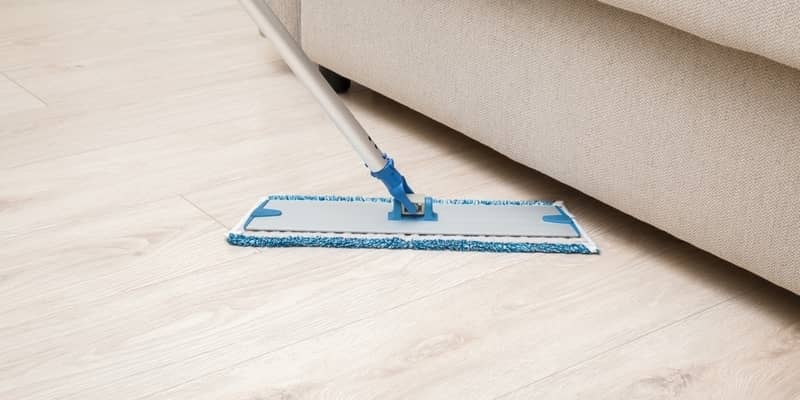
Mop pads are great tools for making the chore of cleaning your home more efficient and fun. Think of them like a sponge that attaches to a handle, so you don’t have to bend over to scrub small spaces.
They provide an easy, hygienic solution to getting floors spotless by acting as a protective barrier between the cleaning tool and various surfaces.
Mop pads range from extra soft to hard fibres, and the type chosen will depend on the job it is being used for. Some mop pads have a scouring side for areas that require tougher cleaning and some can be washed and reused.
Mop Handle
The mop handle is an important part of the overall design because it helps keep your hands off the dirty floor while allowing you to reach into tight spaces like corners or under furniture.
Most handles come in adjustable lengths so that you can adjust them according to your height or preference. Some handles also feature swivel heads, so you can easily manoeuvre them around furniture legs without having to move the furniture.
Mop handles are usually made from wood or metal and some models feature ergonomic grips for extra comfort when mopping for long periods of time.
Mop Bucket
A bucket is essential when using a wet mop because it stores all the dirty water and a fresh cleaning solution.
Some mop buckets come with built-in wringers and these make wringing out your mop easier since they require less physical effort from you. There are also buckets with foot pedals, which are especially useful as they allow you to press down on the pedal with your foot while keeping both hands free so you can hold on to the handle with ease.
How to Clean a Wet Mop
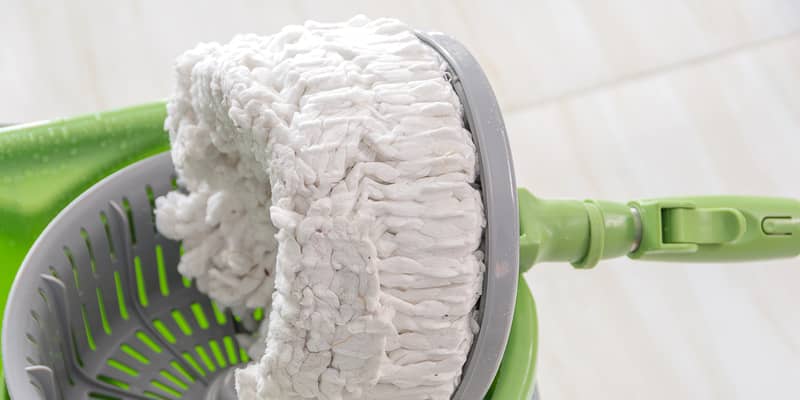
Cleaning Fixed Mop Heads
The method you use to clean a dirty mop head depends on what type you have. There are three primary types of wet mops: string, flat, and microfiber.
- String mops should be soaked in hot water with detergent before wringing them out.
- Flat mops should be washed in warm water with liquid dish soap before being rinsed thoroughly.
- Microfiber mop heads can be hand washed in cold water, without bleach or fabric softener, and then air dried.
Cleaning Solution
You don’t always need to use harsh chemicals to clean your mop head — in fact, you can use simple household ingredients.
- For string or flat mops, mix three litres of hot water with 100g of baking soda or white vinegar and 30g of liquid dish soap for an effective cleaning solution. You can also add 100g bleach for an extra boost of disinfection power.
- For microfiber mops, simply fill the sink with warm soapy water and soak the mop head for about 10 minutes before rinsing it off thoroughly.
How to Clean a Dust Mop
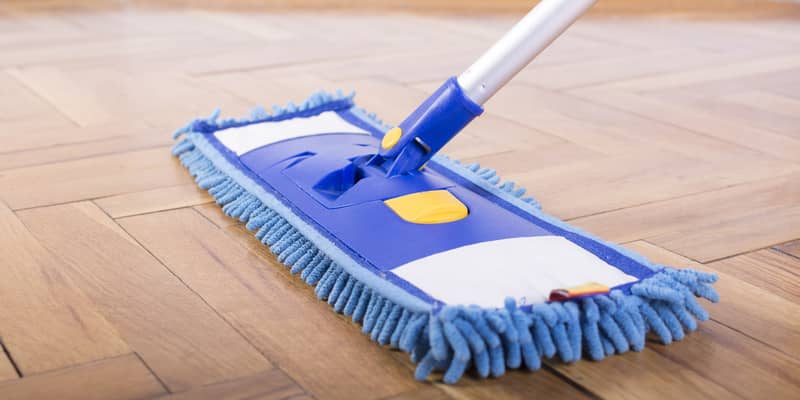
Regularly Remove Dirt and Debris from the Mop Head
The first step in keeping your dry mop clean is to remove debris from the mop head. To do this, simply shake it out over a trash can or run it under hot water to loosen any stuck-on particles. This should be done after each use to make sure your mop is always as clean as possible.
Clean with Soap and Water
You can also use soap and water to give your dry mop a deep clean every once in a while.
- Fill up a bucket with warm water and add some liquid dish soap (or laundry detergent).
- Dip the mop head into the sudsy solution and use your hands to work the soap into the fibres of the head.
- Rinse off all the soap with clean water.
- Allow it to air dry before putting back together again.
Sanitise with Vinegar Solution
For an extra level of sanitation, you can use a vinegar solution to sanitise your dry mop head after cleaning with soap and water.
To make this solution: mix one part white vinegar with four parts hot water in a bucket or bowl. Dip your mop into this mixture, making sure that all the fibres are submerged in the liquid, then let it sit for 10 minutes before rinsing off with cold water and allowing it to air dry completely before reassembling it.
How to Clean Detachable Mop Heads
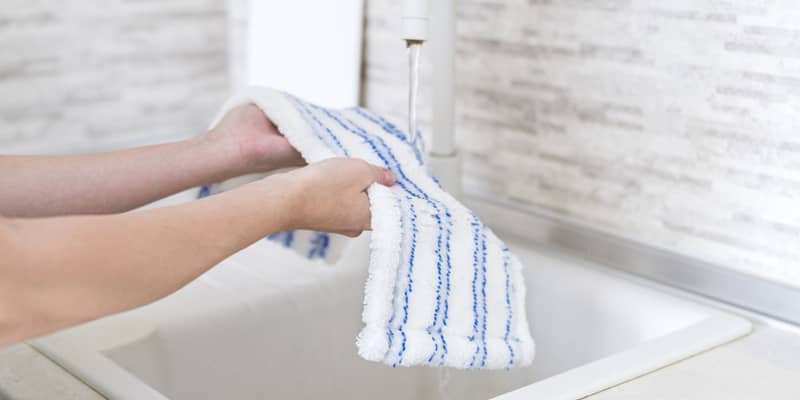
Step 1: Rinse Out Excess Dirt and Debris
The first step is to rinse out excess dirt and debris from your mop head. If you have access to an outdoor hose or faucet, use that for this step.
Otherwise, fill up a bucket with hot water and submerge the mop head until all the dirt is washed away. Once done, wring out any excess moisture from the mop head before proceeding to the next step.
Step 2: Soak in Hot Water with Cleaning Solution
Once the initial rinse is complete, it’s time to do a deep clean of your mop head by soaking it in hot water mixed with bleach, detergent, or vinegar for at least 15 minutes.
- Detergent: Choose a detergent that is designed specifically for mopping and other hard-surface cleaning tasks — this will ensure that it won’t leave any residue on your floors when you mop again.
- Vinegar: Mix equal parts white vinegar and hot water before submerging the mop head in this solution.
- Bleach: Mix 60mL bleach in a 4L bucket of hot water, and let the mop head soak overnight. Then wash it with soap and water.
Step 3: Scrub Away Any Remaining Grime
After soaking for 15 minutes, take out your mop head and scrub away any remaining grime with an old toothbrush or sponge if needed. This ensures that all those pesky little bits of dirt are completely removed so they won’t be transferred onto your floors when mopping again.
Be sure not to scrub too hard though, as this could damage the fibres of the mop head.
Step 4: Wash Mop Heads in Clean Water
Rinse the mop head thoroughly, until the water runs clear. Then wring it out and air dry it completely.
Mop Drying Tips
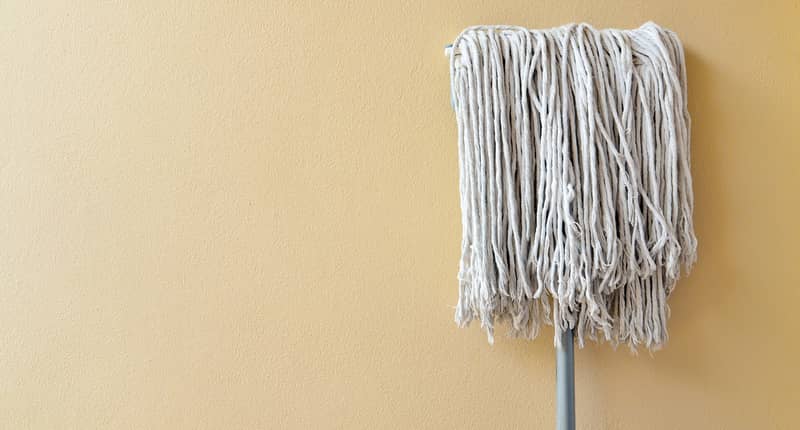
After cleaning your mop head, hang it upright outdoors or in a well-ventilated area so that it has plenty of time to dry completely before storing away. If possible, avoid direct sunlight, as this can cause fading and discolouration.
If you’re using a string or flat mop, make sure to wring out as much excess water as possible before drying it — this will help prevent mould and bacteria growth. For microfiber heads, lay them flat on a towel after washing so that they keep their shape during the drying process.
How to Clean a Mop Bucket
- To clean your mop bucket thoroughly, empty it out and rinse it with hot water.
- Add 500ml of white vinegar or bleach to the bucket and fill the rest with hot water.
- Let the solution sit for 15 minutes before emptying.
- Once you’ve poured out the cleaning solution, rinse the bucket with warm water and air dry.
How Often to Replace Your Mop
How Often to Replace a Mop Handle
Mop handles, often taken for granted, are an essential component of a successful cleaning job. Depending on how often you use it and the quality of your current one, about every six months should be a safe bet for when to switch it out for a new one.
If you find your mop head isn’t staying attached to the handle like it used to, or if you’re having difficulty squeezing out excess water from the mop head, then it’s probably time to replace it.
How Often to Replace a Mop Head
Here are some of the most popular types of mops and how often they should be replaced:
- Cotton or Synthetic Blend: Every 3-6 months
- Disposable Microfibre: Every 1-2 months
- Reusable Microfibre: Every 6-12 months
- Natural Fibre: Every 3-6 months
- Sponge: Every 1-2 months
In addition to the type of mop head you have, how often you clean will also affect how often you need to replace your mop.
If you’re mopping every day, you’ll need to replace your mop more frequently than someone who only mops once a week. A good rule of thumb is to replace your mop every 2-3 months if you’re cleaning daily, and every 4-6 months if you’re cleaning weekly.
How Often to Replace a Mop Bucket
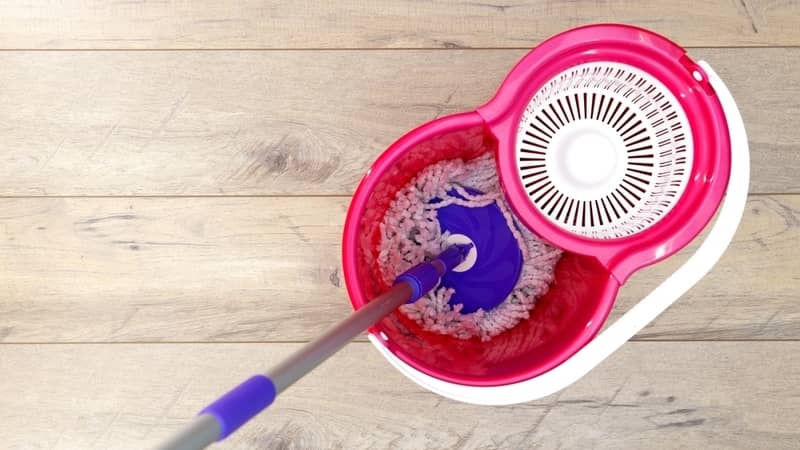
Besides replacing your mop head regularly, you should also be sure to replace your mop bucket when it starts to show signs of wear and tear. Mop buckets can last for years if they’re well-made and well-cared for.
If you start to see cracks or holes in the bucket, it’s time for a new one. A cracked bucket can leak, which means water will get on your floors instead of staying in the bucket where it belongs.
Clean Floors Need a Clean Mop
Keeping your mops clean not only helps them last longer but also ensures they are effective at cleaning and preventing bacteria build up. By following these simple steps, you can easily master how to clean a mop correctly and ensure your home stays sparklingly clean all year round.
Got too much on your plate? A professional cleaning service can make sure you get a thorough job done with minimal effort on your part.

